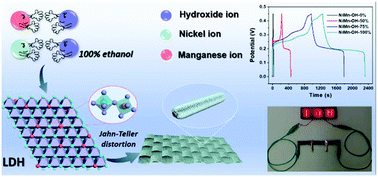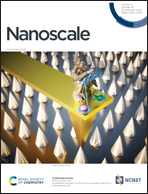Jahn–Teller distortions boost the ultrahigh areal capacity and cycling robustness of holey NiMn-hydroxide nanosheets for flexible energy storage devices†
Abstract
Flexible energy storage devices with ultrahigh areal capacity and excellent cycling stability are highly desired for portable and wearable electronics. Bimetal hydroxides with low crystallinity are preferred as electrode materials due to their advantageous features of high electrochemical performance, rapid ion diffusion and high structure stability enabled by lattice disorder. Herein, holey NiMn-hydroxide (NiMn-OH) nanosheets with abundant lattice disorder induced by Jahn–Teller distortion are grown vertically on carbon cloth and their loading level reaches as high as 3.27 mg cm−2. The obtained NiMn-OH nanosheets demonstrate a superior capacity of 881 μAh cm−2 at 3 mA cm−2 and outstanding rate capability (66.4% capacity retained at 30 mA cm−2). The flexible all-solid hybrid device (NiMn-OH//Fe2O3) delivers a high energy density of 573.8 μW h cm−2 at a power density of 2.4 mW cm−2 and more importantly exhibits good cycling stability with 90.1% retained after 10 000 cycles and mechanical robustness. This proof-of-principle investigation is opening up a viable way to develop high performance electrodes for flexible energy storage devices.

- This article is part of the themed collection: 2020 Nanoscale HOT Article Collection


 Please wait while we load your content...
Please wait while we load your content...